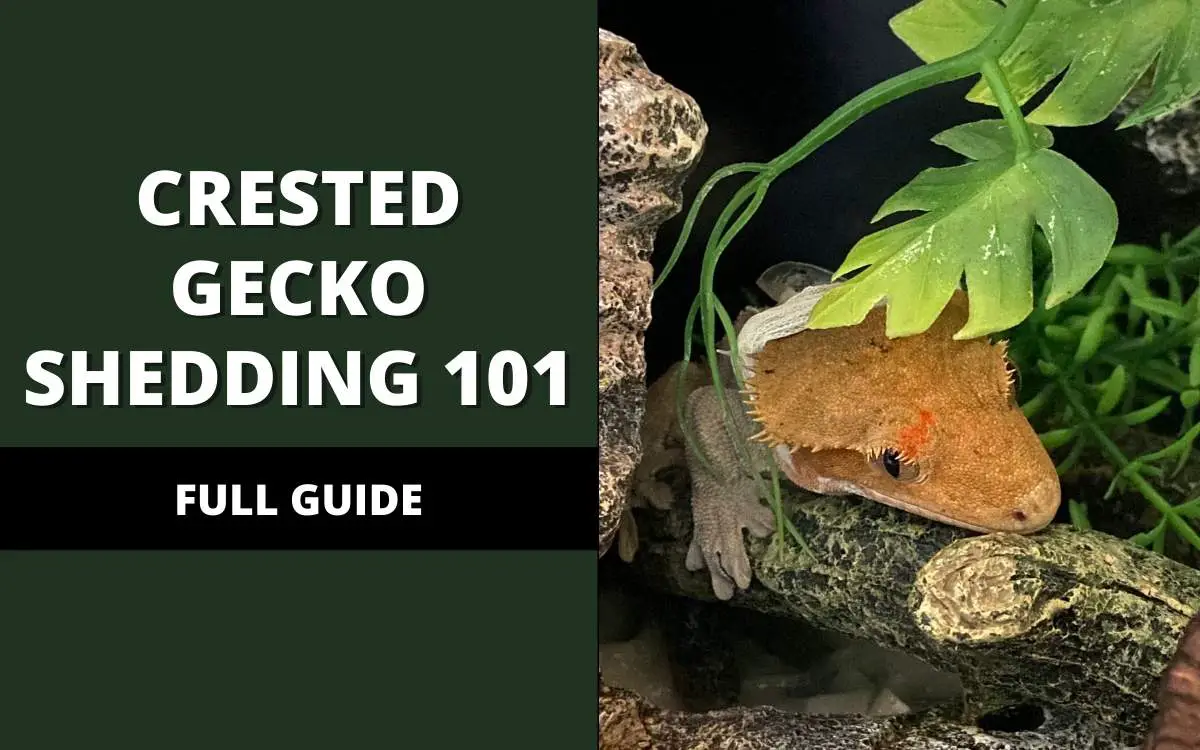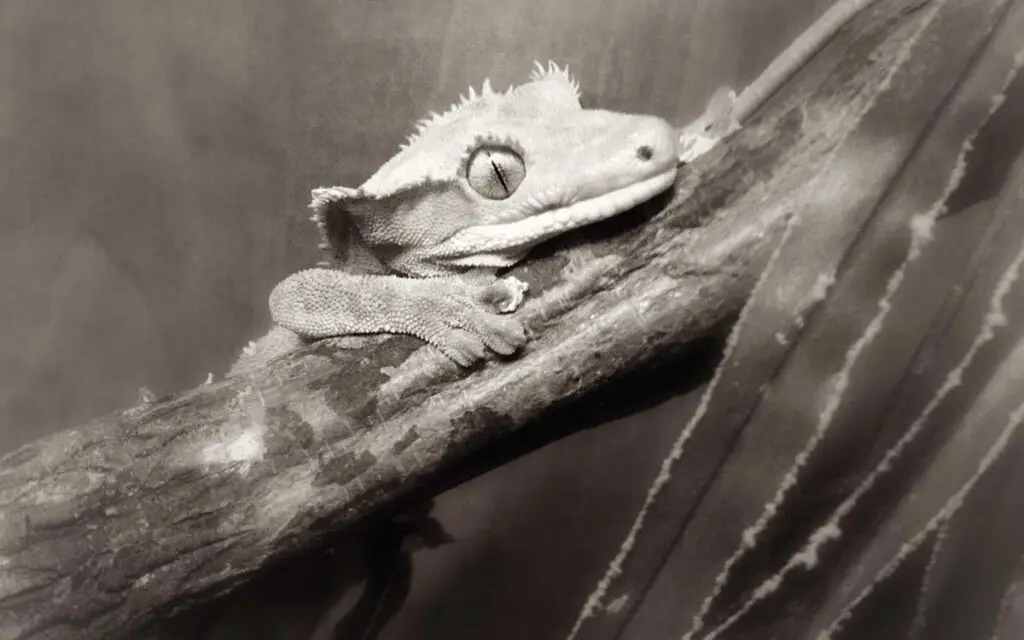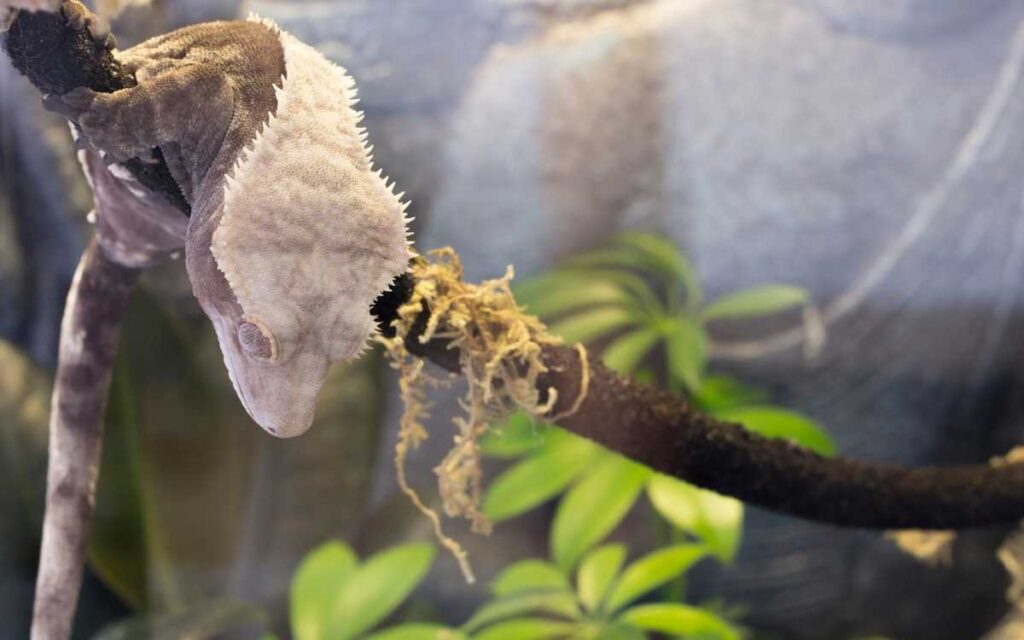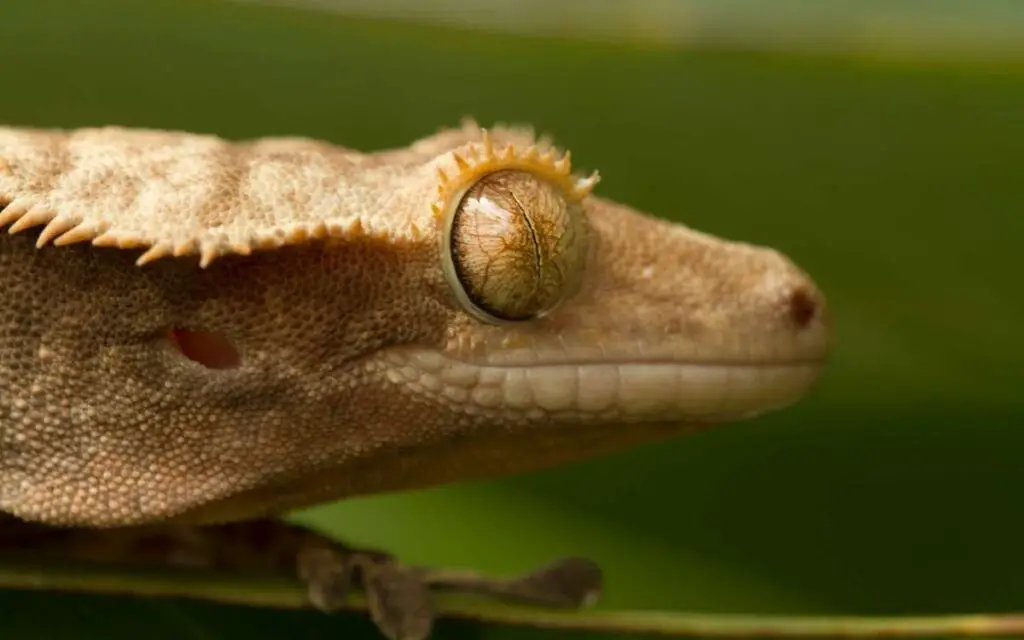Disclaimer: As an Amazon Associate I earn from qualifying purchases. Therefore, we may collect a share of sales from the links on this page, at no extra cost to you!

Crested Gecko Shedding 101
As a reptile owner, your crested gecko shedding its skin is something you’ll occasionally deal with. And although it’s a natural process that should go just fine under normal circumstances, it still helps to know as much information about shedding.
This knowledge will come in handy whenever problems arise during shedding due to certain factors.
This article will explore everything about a crested gecko’s shedding process, including any issue that may come up and what you can do to help your reptile.
Jump to..
Why do Crested Geckos Shed?
Unlike humans and other mammals, a reptile’s skin does not grow with them, and thus, they tend to outgrow their skin. To allow further growth, crested geckos shed their old skin, exposing a new layer. This process is also called molting or sloughing. A crested gecko shedding its skin also allows it to eliminate any parasites that may have accumulated on the old skin. This further benefits their overall health and growth process.

How Often do Crested Geckos Shed?
Because crested geckos outgrow their skin, how often they shed will depend on their age. Young geckos generally shed at a much faster rate than older ones. On average, a hatchling sheds its skin weekly, a juvenile once every two weeks, while an adult will take around three weeks or even a month to shed their old skin. Here is a table showing the average shedding frequency by age.
Age | Shedding frequency |
Hatchling | Weekly |
Juvenile | Two weeks |
Adult | Two weeks to a month |
Every gecko is different though, and if you have a slow-growing or fast-growing gecko, don’t be alarmed if your pet seems to deviate from this timeline.
How Long Does It Take for a Crested Gecko to Shed?
Watching your pet crawl out of its skin is something you’ll be lucky to experience. When the conditions are right, they tend to do it at night, within 15-20 minutes. It usually happens as a single process where the reptile starts by removing the skin on its snout using its tongue. It then proceeds to slowly remove the rest of the skin on its body.
Normally, you won’t even know that your pet has shed its skin because they tend to do all of it. It might seem gross, but it is actually beneficial to the animal. By eating the skin, a crested gecko recovers the nutrients any nutrients it lost during the process. The practice is also an excellent way to eliminate any trail, helping the reptiles put off potential predators in the wild.
Signs of Shedding

It may be hard to witness your gecko shedding its skin, but that doesn’t mean you can’t know when it is about to. These reptiles usually exhibit some outwards signs that will let you know they are about to don some new, glowing skin. Here is what to look out for;
- The most obvious shedding sign is a change in the color and texture of their skin. When a crestie wants to shed its skin, it becomes dry with a pale and dull color.
- Due to dry skin, your pet may experience sticking problems. They will have a harder time scaling their terrarium walls and will often stick to the walls.
- Although crested dragons are not big eaters, they will experience a significant decrease in appetite when it’s time to shed. So, when you notice your pet shunning that juicy cricket for days, they are probably about to ditch their old skin for a new one.
Shedding Problems
Not every shedding process goes as intended; crested geckos run into problems once in a while. Such problems may be due to factors such as low humidity and some underlying health issues. Therefore, you need to be vigilant for any signs of shedding problems in your pet, as these will directly impact their well-being.
How do Shedding Problems Manifest?
A crested gecko having issues during ecdysis will show signs of incomplete shedding. This condition of incomplete shedding in bearded dragons is referred to as dysecdysis and is usually caused by inadequate humidity. If your pet is experiencing dysecdysis, you will notice unshed dead skin on its body, usually around the toes and tails.
Once you see the dead skin, please don’t ignore it; the old skin usually constricts blood flow, putting your crestie at risk of losing its tail, toe, or even a whole limb. Therefore, you will have to remove the skin.
How to Deal with Incomplete Shedding
Helping your crested dragon remove a stuck shed may look straightforward, but it’s far from that. First of all, you can’t just pull off the skin; this will only hurt your pet. There is a better way, which is giving your reptile a sauna. However, this method will also require you to be a little careful not to hurt your animal.
Giving a crested gecko a sauna generally involves placing it on some layers of soaked paper towels for between 10 to 15 minutes to increase the humidity. To protect the reptile from drowning, don’t use too much water and supervise them the entire time. Also, remember that crested geckos are cold-blooded, and thus, the water used to soak the towel should be at room temperature. Anything above 85 degrees F may result in your reptile suffering from a heat stroke.
During the sauna session, the humidity around the gecko will increase to around 80 percent. This causes the stuck shed to become loose, making it more likely to peel off. After about 15 minutes, you can now use a Q-tip or soft toothbrush to brush away the old skin gently. In some cases, not all the skin will come off, but hopefully, the gecko should shed it by themselves. If not, you can also repeat the above procedure for the next few days until all the old skin is gone.
However, not all geckos are patient enough to stay held in a sauna for close to twenty minutes. Your reptile may rebel, but that doesn’t mean you give up and risk it losing a limb. Thankfully, there is another alternative; reptile shedding aids. These let you loosen the stuck shed on your pet reptile without holding them in a wet bath for a long time. You just apply a little amount on the old dead skin and gently massage the area, and it is good to go.
Whatever happens, never pull off the old skin with your hand, even when it is wet. If you don’t have a soft toothbrush or cotton swab, you can use a pair of tweezers, but you must be very careful.
How to Avoid Incomplete Shedding
Since you’re probably a believer in the phrase “prevention is better than cure,” you don’t want to have to manage a stuck shed; you want to stop it from happening. Well, there is a way to do that. Once you notice the signs that your crested gecko wants to shed its old skin, there are certain things you can do to ensure everything goes as planned. These generally involve raising their terrarium humidity to around 80 to 90 percent for short periods, especially at night.
You can do this by using a shedding or moist box. This is a special area in the enclosure with high humidity, usually achieved by placing damp paper towels in the box. It will make a nice hiding area for your gecko, which they can use whenever they want to shed their skin. You can also spray their terrarium more frequently and keep the fogger on for a little more time at night.
However, too much humidity for too long may cause more harm than good to a crested gecko. It can cause the skin damp skin to stick to the gecko, resulting in fungal infections or skin rot. Therefore, make sure you let the terrarium air out during the day to lower the humidity to a more natural 50%. You can also use moisture absorbing substrates like sphagnum moss and coconut husks. These substrates suck in moisture from the air and maintain the terrarium’s humidity at an acceptable level.
Another thing you can do is to provide your pet with some rough surfaces, like tank ornaments and some commercial branches, which they can rub against to help them shed their skin.
What Should I do if the Shedding problems do not stop?
Sometimes a crested gecko shedding problem may go beyond the usual incomplete shedding. One such issue is irregular shedding frequency, which indicates that something is wrong, especially if they start doing it more frequently than usual. Such behavior may be due to sickness or parasites, which your crested gecko may be trying to get rid of by shedding its skin.
Accelerated shedding is not something you can solve at home, and thus, take your gecko to your vet for a check-up.
How do I know my Reptile’s Shedding Frequency?

To know how often your crested gecko sheds its skin, create a shedding log. It might not be easy since these reptiles do it at night, but you can use the shedding signs to guide you. Start keeping records from the moment you purchase your gecko, which will help you notice any irregularities in the shedding cycle.
How Does a Crested Gecko Look After Shedding?
After shedding the old skin, a crested gecko doesn’t look that different from before. This is why you probably won’t notice it shed if you never paid attention to the signs before molting. You may see some brighter colors if you look hard enough, but generally, don’t expect a colorful transformation after your crestie sheds its skin.
Useful Tips on Crested Gecko Shedding
Here are some other things you should try to make sure your crested gecko has a smooth, shedding experience.
· A healthy diet helps
Nutritional deficiency is also known to cause abnormal skin shedding. Therefore, make sure that you always provide your crested gecko with a balanced diet. You can give them commercial food from pet stores and an insect at least twice a week. There are also calcium and multivitamin supplements that you can add to their diet, ensuring maximum nutrition. A balanced diet will keep your reptile healthy and provide it with the required nutrients to ensure it goes through shedding well enough.
However, crested geckos will not eat like before when it’s time to shed their skin. It shouldn’t worry you, but make sure to remove any leftover foods in their terrarium. This prevents any buildup of bacteria in the habitat, protecting your crestie and their new skin from infections.
· Keep them hydrated
The moisture content inside the gecko also matters as much as the one surrounding it. You can include a small bowl of water in the enclosure to keep them hydrated so that when the time for molting arrives, they will be in the best possible condition.
· Avoid handling your gecko during shedding
The skin shedding period can be a bit stressful for a crested gecko, and the last thing they need is to be constantly held and moved. When you notice the pale skin that foreshadows shedding, it’s best to leave your reptile to their means in their terrarium. As long as the conditions there are ample for ecdysis, the gecko will be just fine. You should only get involved when there is incomplete shedding, but you can monitor them for comfort if they are hatchlings or growing juveniles.
In Summary
Shedding is an essential aspect of a crested gecko’s growth. Depending on your gecko’s age, it will happen anywhere between twice a month to once every week. However, you should always try to provide the best possible conditions for your crested gecko if you don’t want them to experience any hiccups as they molt.
But if they do have problems, don’t freak out; you have a responsibility to help them out, and it won’t be a hard thing if done right. Some situations may be worse than others, but your vet should help you sort that out with a specialized diet plan.
